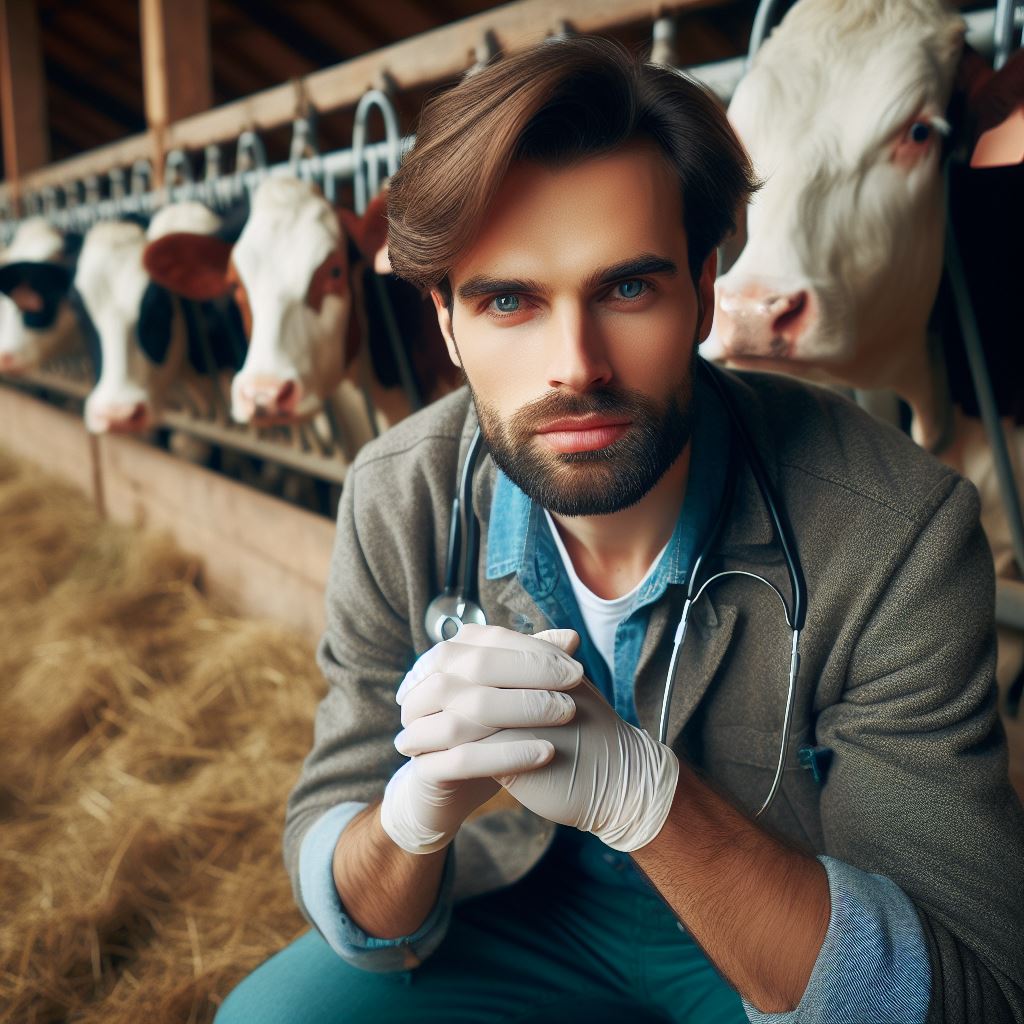Introduction
In livestock farming, health standards are crucial.
They ensure animal welfare and food safety.
This blog post aims to explore the significance of implementing new health standards for livestock.
We’ll delve into how these standards benefit both animals and consumers while promoting sustainable farming practices.
Let’s uncover the key aspects driving the need for updated regulations and how they contribute to a healthier and more ethical livestock industry.
By understanding the importance of these standards, we can work towards a future where livestock farming meets the highest health and welfare criteria.
Join us on this journey to explore the essential role that health standards play in shaping the future of agriculture and ensuring the well-being of both animals and humans.
Background on current health standards for livestock
Overview of existing regulations and guidelines
- Livestock health standards are established to ensure the welfare and safety of animals in commercial farming.
- Regulatory bodies, such as the Department of Agriculture, define the minimum requirements for livestock well-being.
- These regulations cover areas such as housing, nutrition, disease prevention, and veterinary care.
- Guidelines are also provided to assist farmers in implementing best practices for livestock management.
- Existing standards vary across countries and regions, with some having more rigorous requirements than others.
- The aim is to maintain the health and productivity of livestock while minimizing the spread of diseases.
Discussion of the need for updates and improvements
- Rapid advancements in scientific research and knowledge necessitate frequent updates to livestock health standards.
- New diseases and emerging pathogens pose risks to livestock and require proactive measures.
- Improved animal welfare practices have gained recognition, requiring adjustments to existing regulations.
- Consumer demand for ethically and sustainably raised livestock urges the establishment of stricter health standards.
- Inadequate standards may lead to compromised animal welfare, increased disease prevalence, and public health concerns.
- Updating health standards ensures that livestock farmers are equipped with the most effective practices for their industry.
- Scientific studies and expert opinions are considered in the process of revising and enhancing health standards.
- Collaboration among stakeholders, including farmers, veterinarians, and policymakers, is vital for successful improvements.
- Regular monitoring and evaluation of implementation are necessary to ensure compliance with the updated health standards.
- Educational campaigns and training programs help disseminate the new standards and support their adoption.
By comprehensively understanding the background of current health standards for livestock, it becomes evident why updates and improvements are necessary.
The aim is to promote the well-being of animals, protect public health, and meet the evolving expectations of consumers.
With a sound foundation, the focus can now shift towards discussing the specific changes and advancements that should be made in livestock health standards.
Read: Latest USDA Regulations: How They Affect Farmers
Overview of the New Health Standards
Explanation of the Key Changes and Additions
Livestock production plays a crucial role in meeting the global demand for animal-based products.
However, ensuring the health and welfare of livestock is of utmost importance.
To address this concern, new health standards have been developed, focusing on enhancing the well-being of animals.
One of the key changes in the new standards is a more comprehensive approach to disease prevention.
Transform Your Agribusiness
Unlock your farm's potential with expert advice tailored to your needs. Get actionable steps that drive real results.
Get StartedPreviously, the emphasis was primarily on disease treatment.
The updated standards now underscore the significance of proactive measures to prevent diseases through proper animal management, nutrition, and vaccination protocols.
Additionally, the new health standards introduce a rigorous evaluation system for livestock facilities.
It includes regular assessments of animal living conditions, such as housing, ventilation, and cleanliness.
This will ensure that the animals are provided with suitable environments that promote their physical and mental well-being.
Furthermore, the updated standards prioritize the reduction of stress on livestock.
Stress can lead to various health issues and compromise the immune system of animals.
The new guidelines emphasize the importance of minimizing stressors, such as improving handling techniques, reducing transportation time, and providing sufficient space for social interaction among animals.
Another significant addition is the inclusion of guidelines for the responsible use of antibiotics.
With the increasing concern of antibiotic resistance, it is crucial to regulate their use in livestock production.
The new standards promote the judicious use of antibiotics, specifically for therapeutic purposes, while discouraging their routine use for growth promotion.
Analysis of the Intended Impact on Livestock Health and Welfare
The implementation of these new health standards is expected to have a positive impact on the overall health and welfare of livestock.
By focusing on disease prevention, rather than just treatment, the standards aim to reduce the occurrence of illnesses in animals.
This will not only improve their quality of life but also minimize the need for antibiotics, leading to a decrease in antibiotic resistance.
Furthermore, the comprehensive evaluation system for livestock facilities will ensure that animals are provided with optimal living conditions.
Proper housing, ventilation, and cleanliness will contribute to healthier animals, reducing the risk of disease transmission and improving their overall well-being.
The reduction of stressors on livestock will also have a profound effect on their health.
Minimizing stress levels can enhance the immune system, making animals more resilient to diseases.
Additionally, reducing transportation time and improving handling techniques will minimize the physical and psychological stress experienced by animals during farming practices.
By promoting responsible use of antibiotics, the new standards address the global concern of antibiotic resistance.
The guidelines ensure that antibiotics are only used when necessary, preventing their overuse and reducing the risk of developing resistant bacterial strains in livestock populations.
In general, the new health standards for livestock mark a significant shift towards a more proactive approach to animal well-being.
By focusing on disease prevention, improving living conditions, reducing stressors, and regulating antibiotic use, these standards aim to enhance the overall health and welfare of livestock, benefiting both animals and consumers.
The implementation of these standards will contribute to sustainable and ethical livestock production, meeting the global demand for animal-based products while ensuring the well-being of animals.
Showcase Your Farming Business
Publish your professional farming services profile on our blog for a one-time fee of $200 and reach a dedicated audience of farmers and agribusiness owners.
Publish Your ProfileRead: Agricultural Subsidies in 2024: A Detailed Overview
Detailed discussion of specific changes
Improved biosecurity measures
Biosecurity measures play a crucial role in ensuring the health and well-being of livestock.
With the introduction of stricter protocols for disease prevention, farms are better equipped to mitigate the risks of infectious diseases.
Previously, some farms may have followed lax biosecurity measures, leading to disease outbreaks that could have been prevented.
However, with the establishment of more stringent protocols, such as maintaining restricted access and biocontainment areas, the likelihood of infection spreading has significantly decreased.
In addition to these protocols, the implementation of vaccination requirements and monitoring systems has become a standard practice.
Vaccinations are essential in preventing the spread of various diseases among livestock.
By ensuring that animals are regularly vaccinated, farmers can significantly reduce the risk of outbreaks.
Furthermore, monitoring systems are now in place to track the vaccination status of each animal, allowing for timely interventions and necessary follow-ups.
This proactive approach helps maintain a healthy livestock population and increases overall farm productivity.
Enhanced animal welfare practices
Animal welfare is an essential aspect of livestock farming, and the industry is continuously striving to improve practices in this area.
One significant change revolves around providing more space and enrichment opportunities for the animals.
In the past, livestock may have been confined to small and cramped spaces, hindering their natural behavior and overall well-being.
However, with revised health standards, farmers are now required to ensure adequate space for each animal.
This not only allows them to move freely but also improves their comfort levels and reduces the likelihood of stress-related diseases.
Moreover, the adoption of low-stress handling techniques has gained prominence in recent years.
Livestock can experience significant stress during transportation and other handling processes.
To address this, farmers are now encouraged to adopt practices that minimize stress and promote gentle handling.
By doing so, the animals experience less fear and anxiety, leading to improved welfare and better-quality meat.
These changes not only benefit the animals but also contribute to a positive public perception of the industry.
Strengthened medication regulations
Proper medication management is crucial to prevent the emergence of antimicrobial resistance and protect both animal and human health.
To address this concern, health standards have been revised to include strengthened medication regulations.
One significant change is the tightened guidelines for antibiotic usage.
The overuse and misuse of antibiotics in livestock farming can contribute to the development of antibiotic-resistant bacteria, posing a threat to public health.
To tackle this issue, farmers are now required to strictly adhere to dosage instructions and withdrawal periods.
Furthermore, the promotion of responsible antimicrobial stewardship has become a key priority.
Veterinarians, farmers, and other stakeholders are encouraged to use antibiotics judiciously, following best practices outlined by regulatory authorities.
This includes properly diagnosing illnesses, considering alternative treatment options, and only using antibiotics when necessary.
The implementation of these regulations ensures that antibiotics are used prudently, preserving their effectiveness for both animals and humans.
This approach contributes to a more sustainable and responsible livestock industry.
Read: US-EU Trade Deal: Effects on Farm Exports

Challenges and considerations in implementing the new standards
Potential cost implications for farmers and producers
Implementing new health standards for livestock is not without its challenges.
One significant consideration is the potential cost implications for farmers and producers.
Meeting the new standards may require substantial investments in infrastructure upgrades and improved animal welfare practices.
These expenses could ultimately be passed down to consumers, resulting in higher prices for livestock products.
The financial burden may disproportionately affect small-scale farmers, who may struggle to afford the necessary changes, putting them at a disadvantage compared to larger operations.
To alleviate these concerns, government subsidies or financial assistance programs could be implemented to support farmers in adopting the new standards.
Training and education needs for stakeholders
Another important challenge is ensuring that all stakeholders receive adequate training and education on the new standards.
Farmers, veterinarians, and workers involved in livestock production need to understand and implement the requirements effectively.
Training programs should cover essential topics such as animal care practices, disease prevention, and maintenance of hygiene protocols.
Showcase Your Farming Business
Publish your professional farming services profile on our blog for a one-time fee of $200 and reach a dedicated audience of farmers and agribusiness owners.
Publish Your ProfileCollaboration with agricultural universities and organizations can provide valuable resources and expertise to develop comprehensive training initiatives.
Continuous education and support are crucial to maintaining long-term compliance with the new standards.
Examination of potential resistance or opposition from industry players
In addition to financial and education considerations, potential resistance or opposition from industry players can impede the implementation of new health standards.
Some farmers and producers may resist additional regulations and costs, fearing their impact on profitability.
Lobbying efforts by industry players could potentially delay or weaken the implementation of the new standards.
Overcoming this opposition requires building consensus through open dialogue and addressing concerns.
Effective communication and transparency about the benefits of the new standards can also help reduce resistance and gain industry support.
To maximize the successful implementation of new health standards for livestock, it is crucial to address the challenges and considerations mentioned above.
By providing financial support, offering comprehensive training and education, and maintaining open communication with industry players, a smooth transition to the new standards can be achieved.
The long-term benefits of improved animal welfare, disease prevention, and consumer trust in livestock products make these efforts worthwhile.
Read: Farming Aid Laws: 2024’s Comprehensive Guide
Benefits and Potential Outcomes of the New Health Standards
Improved Overall Health and Well-being of Livestock
Livestock will receive better care, leading to improved health and overall well-being.
Proper nutrition and veterinary care will help prevent common diseases and health issues.
Reduced stress levels and enhanced living conditions will contribute to healthier livestock.
Overall, the implementation of new health standards for livestock brings numerous benefits and potential outcomes.
One essential advantage is the improved overall health and well-being of livestock.
These standards ensure that livestock receive optimal care, leading to better health and higher quality of life.
Livestock farmers will be required to provide proper nutrition, veterinary care, and suitable living conditions to prevent common diseases.
Reduction in Disease Transmission and Foodborne Illnesses
Strict health standards will require regular monitoring and testing for livestock diseases.
Early detection and prompt treatment of diseases will prevent their spread within livestock populations.
Reduced disease transmission will result in lower risks of foodborne illnesses in livestock products.
A reduction in disease transmission and foodborne illnesses is another significant outcome of enforcing strict health standards.
Regular monitoring and testing for livestock diseases will allow early detection and prompt treatment, preventing the spread of diseases within livestock populations.
This reduction in disease transmission will ultimately decrease the risks of foodborne illnesses associated with consuming livestock products.
Enhanced Consumer Confidence in the Safety and Quality of Livestock Products
Clear health standards will assure consumers that livestock products meet high safety and quality standards.
Transparent labeling and certification processes will increase consumer trust in the industry.
Increased consumer confidence will lead to higher demand and a boost in the livestock industry.
Furthermore, the new health standards will enhance consumer confidence in the safety and quality of livestock products.
With clear standards in place, consumers can trust that the products they purchase meet high safety and quality requirements.
Transparent labeling and certification processes will further assure consumers, increasing their trust in the industry.
As a result, consumer confidence will rise, leading to a surge in demand for livestock products and providing a positive boost to the entire livestock industry.
Generally, the implementation of new health standards for livestock brings a range of benefits and potential outcomes.
Livestock will experience improved health and well-being, thanks to better care and suitable living conditions.
Disease transmission and foodborne illnesses will be reduced through regular monitoring and prompt treatment.
Finally, consumer confidence will be enhanced as transparent standards and certification processes ensure the safety and quality of livestock products.
These advantages highlight the importance of embracing and enforcing these new health standards to ensure a thriving and sustainable livestock industry.
Conclusion
Recap of the importance of new health standards for livestock farming
To recap, the implementation of new health standards for livestock farming is of utmost importance.
It ensures the well-being of animals, safeguards public health, and promotes sustainable farming practices.
As responsible consumers, we have to stay informed about updates in these standards.
Encouragement for readers to stay informed about updates and support responsible farming practices
By supporting and advocating for responsible farming practices, we can contribute to a healthier and more ethical food system.
Showcase Your Farming Business
Publish your professional farming services profile on our blog for a one-time fee of $200 and reach a dedicated audience of farmers and agribusiness owners.
Publish Your ProfileAdditionally, staying informed enables us to make better choices when purchasing animal products.
It allows us to support farmers who prioritize the welfare of their livestock and adopt sustainable practices.
Remember, our choices have the power to shape the future of livestock farming and the overall food industry.
So, let’s pledge to stay informed, support responsible farming practices, and demand higher health standards for livestock.
Together, we can make a difference and create a more sustainable, humane, and healthier world for both animals and humans.




